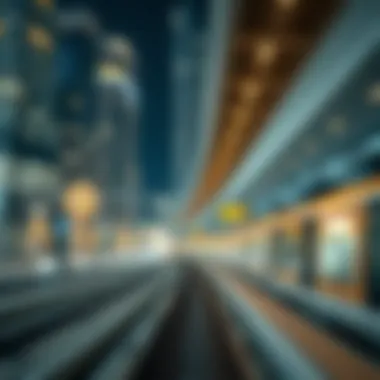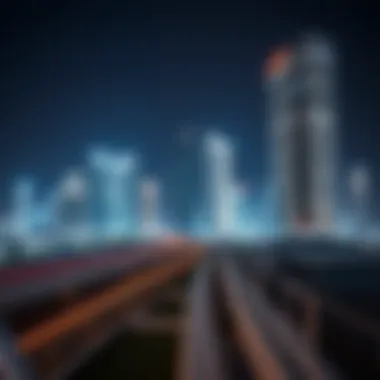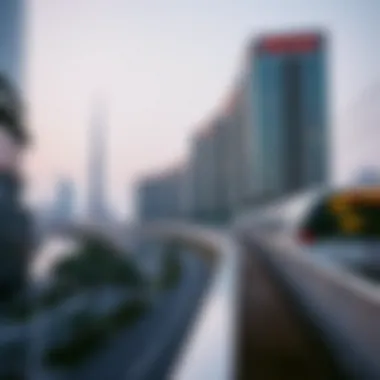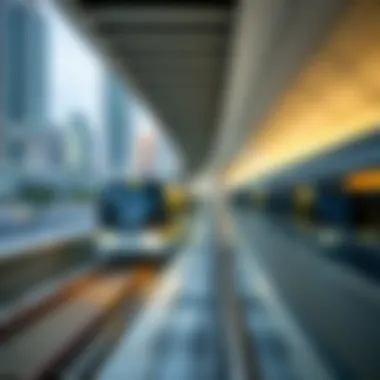Strategic Development of the Metro Dubai Plan


Intro
Dubai has transformed remarkably over just a few decades, from a modest fishing village to a global hub of commerce and tourism. At the heart of this metamorphosis is the Metro Dubai Plan, a critical component of the city’s ongoing development strategy. This article explores the intricacies of the metro system, shedding light on its significant role in urban mobility, real estate dynamics, and socioeconomic evolution.
The Metro Dubai not only reshapes the way residents and tourists navigate the city but also influences various sectors, such as real estate investment and urban planning. Through a systematic exploration, this comprehensive guide aims to equip investors, realtors, analysts, and developers with the insights needed to understand the implications of the Metro Dubai Plan on the city's ever-evolving landscape.
Preamble to the Metro Dubai Plan
The Metro Dubai Plan signifies a notable evolution in urban transit solutions tailored for a rapidly expanding metropolitan landscape. As Dubai transforms from a desert outpost to a bustling global hub, the demand for efficient transportation has surged. This initiative reflects not just a response to transportation needs but encapsulates the broader ambitions of Dubai's urban development strategy. Understanding the fundamentals of the Metro plan is crucial for stakeholders, including investors, realtors, analysts, and developers, as it stands to influence the fabric of urban life within the emirate.
Overview of Dubai's Urban Mobility Needs
Dubai experiences a unique set of urban mobility challenges, driven by a combination of factors such as a growing population, tourism, and economic diversification. Navigating this vibrant city can often feel like a daunting task, especially with heavy traffic and inadequate public transport options in the past. Citizens and visitors alike faced long travel times — a situation that necessitated immediate action. The Metro was introduced as a pivotal solution to alleviate traffic congestion and enhance connectivity across the diverse neighborhoods of Dubai.
Among the pressing needs identified were:
- Seamless Connectivity: Link various parts of the city to ease travel for daily commuters, tourists, and businesses.
- Sustainability Initiatives: Reduce carbon emissions and environmental impact by shifting more commuters to public transit.
- Economic Facilitation: Support local businesses and real estate developments that thrive on increased accessibility.
The public demand for a reliable, efficient, and sustainable transportation system drove the city planners to design a system that not only addresses immediate needs but is poised for future advancements and expansions.
The Vision Behind the Metro System
The vision for the Metro Dubai Plan was born out of a desire to reshape how residents and visitors perceive mobility in urban settings. This isn’t simply about laying down tracks; it's about transforming the culture of transportation. Leaders sought to create a world-class transit system that exemplified both modernity and forward-thinking principles in urban planning. The Metro system aimed to encourage a shift from private car ownership to public transport reliance, significantly impacting how the city moves and breathes.
Within this vision lies several core principles:
- Innovation in Design: Incorporating cutting-edge technology and high-speed capabilities to ensure comfort and efficiency.
- User-Centric Planning: Stations and routes are designed with accessibility in mind, catering to all demographics, including those with disabilities.
- Integration with Urban Development: Create an ecosystem where the Metro promotes and enhances real estate value and urban aesthetics.
"A visionary transport framework lays the groundwork for a sustainable urban future, fostering economic development and enhancing livability."
In summation, the Metro Dubai Plan is an ambitious step not only towards solving current urban mobility issues but also a critical investment in the future dynamics of the Dubai metropolitan landscape. As the project unfolds, it will undoubtedly demonstrate its critical role in shaping the socio-economic landscape of the region.
Historical Context of Public Transport in Dubai
Understanding the past of public transport in Dubai provides vital insight into the current and future developments of the Metro Dubai Plan. This context establishes the foundation upon which the metro system was envisioned. The growth of Dubai’s transport network mirrors the city’s rapid transformation from a small trading port into a metropolis known for innovation and grandeur.
Transportation Evolution in the Emirates
The evolution of transport in the Emirates has seen remarkable shifts. Initially, Dubai's transportation primarily relied on traditional forms such as camels and dhows for trade. As the city expanded in the 20th century, more modern modes began to emerge. The introduction of automobiles revolutionized personal and public transit. However, with the sharp increase in population and economic activity, a pressing need for a structured transport system became apparent.
- 1970s: The first public buses were launched, marking a shift towards organized transit.
- 1980s: Expansion of road networks began to take shape, aiding both local and international connectivity.
- 1990s: The introduction of taxis provided an essential service for residents and visitors alike.
- 2000s: The groundwork for the metro system was laid, recognizing that merely expanding roads is not enough for sustainable growth.
The transition from rudimentary means of transport to a highly organized public transport infrastructure reflects not just technological advancement but also a readiness to embrace modernity. The choice to invest in the Metro Dubai Plan was a significant step towards accommodating the rapid urbanization in a sustainable manner.


Key Milestones Leading to Metro Development
Several milestones punctuate the journey to establishing the metro system in Dubai, showcasing the city’s ambitions and strategic foresight. These developments were essential to address the increasing demands placed on transportation systems within an ever-evolving city.
- 2003: The Dubai Rail Agency was established, aligning with the vision to create a cutting-edge mass transit system.
- 2005: Construction of the metro commenced, and excitement began to brew within the community and among stakeholders. The alignment of the initial lines was planned to cover critical areas of the city.
- 2009: The Red Line officially opened, marking the first phase of the Metro service. Its functioning initiated the pursuit of a coherent urban transport model, particularly interlinking vital areas between Burj Khalifa and the Dubai Marina.
- 2010-2011: The completion of the Green Line opened further routes, encompassing local neighborhoods and easing transit across the city.
These milestones not only highlight the progression of urban transport in Dubai but also underline a keen awareness of environmental impact and urban sustainability. The metro system is a cornerstone of the city, unifying modern aspirations with historical development. It is a leap into the future while respecting the roots from which it emerged.
“Dubai's Metro is not just about moving people; it's about shaping the future of urban living.”
Core Components of the Metro Dubai Infrastructure
The backbone of any transportation system is its infrastructure, and the Metro Dubai system is no different. The core components of this metro system form the very essence of how urban mobility is facilitated in a bustling metropolis like Dubai. Understanding these components grants insight into the operational efficiency, accessibility, and future scalability of Dubai's metro network, thus making it paramount for potential investors, developers, and urban planners to be well-acquainted with these details.
Network Design and Route Planning
When it comes to network design and route planning, there's a method to the madness. The routes of the Metro Dubai aren't just randomly thrown together; they are meticulously crafted to serve the most densely populated and commercially vibrant areas. The planners took a close look at population density maps, current traffic patterns, and future growth projections while designing the network.
The alignment of the metro tracks has also been engineered to minimize disruption to existing infrastructure and buildings. For instance, the Red Line cleverly skirts the waterfront, providing a scenic route while maintaining accessibility to popular spots like the Burj Khalifa and the Dubai Mall.
The effectiveness of this route planning can be observed in the substantial ridership numbers. In peak hours, the metro transports hundreds of thousands of commuters, substantially alleviating road traffic and reducing journey times. Why sit in a car for an hour when you can glide through the city in merely twenty minutes?
Station Features and Accessibility
Let’s shift gears and focus on station features and accessibility, because functional details truly make or break a user experience. The Metro Dubai stations are not just transit points; they are hubs of activity and comfort. Each station is equipped with amenities that prioritize user convenience, like ticket vending machines in multiple languages and dedicated areas for families.
Beyond the basics, the integration of accessibility features ensures that everyone, from wheelchair users to parents with strollers, can navigate the stations easily. Wide elevators, ramps, and tactile guidance paths are not merely add-ons; they are essential to creating an inclusive environment.
Here’s a point worth noting: the architectural design of each station also reflects the cultural essence of Dubai, harmonizing modern aesthetics with traditional elements. The result? A commuter experience that is both functional and visually noteworthy.
Integration with Other Transportation Modes
No metro system is an island unto itself; integration with other transportation modes is key for seamless travel. In Dubai, this integration has been thought through meticulously. The Metro is designed to complement an array of transport options, including buses, taxis, and even the highly popular tram system.
This multi-modal approach allows commuters to transition effortlessly from one mode of transport to another. For instance, key metro stations often coincide with major bus terminals, facilitating easy transfers. The RTA (Roads and Transport Authority) has implemented standardized fare systems across these networks, which is a lifesaver for those whose journeys require these transfers.
In addition, key points of interest, such as Dubai International Airport, are directly linked to the metro. This enhances the appeal for investors and travelers alike by reducing downtime, making Dubai increasingly attractive as a business and tourist destination.
"The summation of these interconnected systems contributes not only to individual convenience but to the overall economic dynamism of the region."
Understanding the core components of the Metro Dubai Infrastructure gives a clearer picture of how this project is designed to address the immediate needs of the urban populace while anticipating future developments and integrative opportunities. As the metro continues to evolve, so too will its potential contributions to Dubai's status as a global city.
Technological Innovations in Metro Operations


Technological advancements play a crucial role in shaping the efficiency and effectiveness of the Metro Dubai network. Innovations are not just an accessory; they are embedded into the very fabric of operations, influencing everything from how trains are run to how passengers interact with the system. These innovations enhance user experience, improve safety, and optimize operational efficiency, all while driving the overall objectives of Dubai's urban mobility strategy.
Automated Train Control Systems
At the heart of Metro Dubai’s operational prowess are the Automated Train Control Systems. These systems ensure precise train movements, reducing the potential for human error and facilitating high-frequency scheduling.
"This system is not merely an enhancement; it’s about making travel smoother and more reliable for daily commuters."
Essentially, automated systems manage train speed and stopping sequences through a real-time data flow that collects information from tracks, trains, and signals. This leads to:
- Improved Safety: By minimizing human intervention, the risk of accidents can drop significantly.
- Increased Efficiency: Shorter headways make for a more responsive train system. Trains can run closer together without compromising safety.
- Energy Conservation: Optimized braking and acceleration save energy, contributing to both operational cost savings and environmental goals.
The results have been evident, with a noticeable reduction in delays. The ability for trains to adapt to fluctuating passenger volumes indicates a forward-thinking approach that prioritizes user experience.
Real-Time Passenger Information Systems
Another vital cog in the wheel of Metro operations is the Real-Time Passenger Information Systems (RTPIS). Never underestimate the societal expectation for instant information, especially in a city like Dubai, where time is of the essence.
RTPIS provides live updates on train arrivals, delays, and platform changes, accessible through digital displays in stations and even through mobile apps. This technology is significant for multiple reasons:
- Enhanced User Experience: With real-time data, commuters are more in control of their travel plans, making journeys less stressful.
- Informed Decision-Making: Passengers can decide the best time to depart, reducing congestion and improving flow.
- Improved Service Monitoring: The data gathered can also help administrators identify patterns in service usage, enabling proactive improvements.
These systems create an atmosphere of transparency and trust, essential for maintaining user satisfaction and encouraging more residents to choose public transport over cars.
Impact on Socioeconomic Development
In the heart of Dubai's urban tapestry, the introduction of the Metro system plays a substantial role in reshaping the socioeconomic landscape. With public transportation being a cornerstone of any urban setting, the Metro is not only a means of getting from point A to point B; it symbolizes a commitment to advancement, both socially and economically. This section will unpack how the Metro enhances connectivity, boosts local economies, and takes into account sustainability.
Enhancing Connectivity and Accessibility
The Metro system stands as a beacon of connectivity for both residents and visitors. An efficient mass transit system eliminates many barriers, making travel seamless and expansive. This connectivity particularly benefits those living in suburban areas who can now access the central business districts easily. For instance, areas like Al Quoz and Dubai Marina have seen an uptick in commuters taking advantage of rapid transit.
Moreover, accessibility ramps and designated pathways ensure that the Metro is user-friendly for everyone, including individuals with disabilities. The integration of smart card systems supports efficient fare collection, making every journey smooth. By reducing the time spent on transportation, individuals can enjoy a better quality of life and focus on work, education, or leisure activities without the constant worry of traffic snags.
Boosting Local Economies and Property Values
The Metro doesn't just transport people; it stimulates economic activity, creating a ripple effect that enhances local markets. Real estate developers keen on capitalizing on this growth have begun investing in areas adjacent to Metro stations, leading to increased property values.
"A well-positioned Metro station can elevate property prices by several percentage points, drawing in investors like moths to a flame."
Local businesses also benefit significantly from increased foot traffic. Cafes, retail shops, and service providers flourish in these bustling areas. Additionally, employment opportunities spring up near stations, transforming previously quiet neighborhoods into thriving economic hubs. Merchants have discovered that proximity to a Metro stop can be a game-changer for their business longevity and growth.
Sustainability and Environmental Considerations


In an age where climate change is at the forefront of global concerns, the Metro's design takes sustainability seriously. The reduction of road traffic leads to lower carbon emissions, directly contributing to improved air quality in Dubai. This environmentally friendly transport option represents a shift towards urban sustainability, easing the burden on an already congested road system.
Investments in renewable energy sources, like solar panels on station rooftops, align with Dubai's broader initiative to become a green city. Efforts such as water management systems within the stations help minimize waste, signaling a commitment to environmental stewardship.
Furthermore, when viewed holistically, the Metro is not merely a transit solution. It serves as a cornerstone on which other layers of urban development rest, thereby addressing the pressing need for a sustainable future without sacrificing economic growth. By focusing on reducing the carbon footprint, enhancing accessibility, and uplifting local economies, the Metro is, in essence, a transformative element in Dubai's grand urban narrative.
Future Expansions and Innovations
Future expansions and innovations in the Metro Dubai Plan are fundamental to addressing the evolving transportation needs of Dubai. In a city characterized by its rapid growth and development, planning for future expansions isn't just a precaution—it's a necessity. This part of the article will delve into various aspects including potential new lines, extensions to existing services, and the overarching vision that guides these developments toward a sustainable urban future.
Projected New Lines and Extensions
Projected new lines and extensions form a critical part of improving the connectivity within Dubai and beyond. As the city continues to grow, so too does the demand for efficient public transport connections that cater to the increasing population. This means one must look at proposals such as:
- New routes to emerging districts: Areas such as Dubai South, which is undergoing significant development, are prime candidates for new Metro lines. The anticipated growth in housing and commercial activities here provides a strong incentive to extend services.
- Linking airports and business hubs: Proposals for extending lines to the Al Maktoum International Airport and the burgeoning Dubai World Central would greatly enhance accessibility for travelers and boost local business potential.
- Integration with regional transport: Future extensions may see Metro lines connecting with other emirates such as Abu Dhabi, reinforcing the position of Dubai as a regional transport hub.
Investors and developers can see the potential for substantial return on investment in areas adjacent to new stations, as these developments typically lead to increased property values and enhanced economic activity. Moreover, accommodating these infrastructures fosters a more connected community, minimizing the reliance on personal vehicles.
Vision for a Sustainable Urban Future
A sustainable urban future hinges on the successful integration of green practices into the expansion of public transportation systems. The Metro Dubai Plan is committed to embedding sustainability into its framework, with a vision that includes:
- Eco-friendly technologies: The Metro system already boasts energy-efficient trains, but future expansions may incorporate even greener solutions, such as solar-powered stations or regenerative braking systems that harness energy.
- Smart city initiatives: Innovations such as smart traffic management systems and electric buses can work in tandem with the Metro, creating a holistic transport network that prioritizes efficiency and low carbon emissions.
- Designed for inclusivity and accessibility: The new projects aim to ensure that all segments of the population can benefit from metro services, with enhanced facilities for persons with reduced mobility and comprehensive bicycle storage solutions.
To successfully navigate the challenges of urbanization while promoting economic growth, it is crucial that Dubai's transportation planning remain forward-thinking and adaptable. This vision not only serves those investing in real estate but also aligns with global trends towards sustainability and environmental awareness.
"Investments in public transport are investments in the future we want to create."
Overall, the expansions and innovations within the Metro Dubai system signify a shift towards a more interconnected and sustainable urban landscape. They promise not only to ease congestion and enhance mobility but also to uplift surrounding communities and contribute positively to the local economy.
The End: The Role of Metro within Dubai's Urban Landscape
The Metro system stands as a cornerstone in shaping Dubai’s urban environment. In a city notable for its rapid growth and dazzling architectural feats, the role of the Metro transcends mere transportation; it is a catalyst for social and economic changes in the region. This conclusion seeks to encapsulate the pivotal impact that the Metro has on Dubai’s urban landscape, focusing on its intertwined benefits, challenges, and future prospects.
Summing Up the Impact of Metro
The Metro Dubai system has significantly altered the way people interact with the city. Through its extensive network, it has brought diverse communities closer together, enhancing mobility and fostering a sense of unity among residents and visitors alike. The strategic placement of stations throughout high-density areas has played a significant part in mitigating traffic congestion. Not only has it reduced dependence on cars, but it has also improved air quality by cutting down on emissions from vehicles.
Additionally, convenience has become a hallmark of the Metro system. Frequent service and well-integrated routes allow for seamless transitions between different modes of transportation, whether it’s the bus service or the tram system. This level of connectivity not only saves time for commuters, enabling them to better manage their daily schedules, but also provides businesses with access to a wider pool of customers. On the economic front, improved footfall has led to thriving local businesses near Metro stations, revitalizing neighborhoods and stimulating economic growth.
"Efficient public transport isn’t just about moving people; it’s about building connections and fostering economic vitality within communities."
The Road Ahead for Transportation in Dubai
Looking forward, various expansions and innovations are on the horizon for Dubai's Metro system. Plans are in the works for new lines and extensions, stretching into previously less accessible areas. This ambition aims to address the ever-increasing population and evolving urban dynamics while supporting the city’s ongoing commitment to sustainability.
Moreover, promises of implementing cutting-edge technologies, such as AI and machine learning, hold the potential to boost operational efficiency and enhance the overall passenger experience. As Dubai gears towards becoming a smart city, the integration of information technology within public transport systems is inevitable. Expect real-time data analytics to optimize train services further and address punctuality issues more precisely.
Urban development will continue to be intimately linked to Metro expansion. Areas surrounding new station sites are likely to experience increased real estate investment and development opportunities. This symbiotic relationship ensures that the Metro is not merely a transport solution but a foundational element in Dubai’s urban strategy.











